|
|
Children
with Communication Disorders
What is Meant by "Communication
Disorders"?
The term "communication disorders" encompasses a wide variety
of problems in language, speech, and hearing. Speech and language impairments
include articulation problems, voice disorders, fluency problems (such
as stuttering), aphasia (difficulty in using words, usually as a result
of a brain injury), and delays in speech and/or language. Speech and language
delays may be due to many factors, including environmental factors or
hearing loss.
Hearing impairments include partial hearing and deafness. Deafness may
be defined as a loss sufficient to make auditory communication difficult
or impossible without amplification. There are four types of hearing loss.
Conductive hearing losses are caused by diseases or obstructions in the
outer or middle ear and can usually be helped with a hearing aid. Sensorineural
losses result from damage to the sensory hair cells of the inner ear or
the nerves that supply it and may not respond to the use of a hearing
aid. Mixed hearing losses are those in which the problem occurs both in
the outer or middle ear and in the inner ear. A central hearing loss results
from damage to the nerves or brain.
Many communication disorders result from other conditions such as learning
disabilities, cerebral palsy, mental retardation, or cleft lip or cleft
palate.
How Many Children Have Communication
Disorders?
The overall estimate for speech and language disorders is widely agreed
to be 5% of school-aged children. This figure includes voice disorders
(3%) and stuttering (1%). The incidence of elementary school children
who exhibit delayed phonological (articulation) development is 2% to 3%,
although the percentage decreases steadily with age.
Estimates of hearing impairments vary considerably, with one widely accepted
figure of 5% representing the portion of school-aged children with hearing
levels outside the normal range. Of this number, 10% to 20% require some
type of special education. Approximately one-third of students who are
deaf attend residential schools. Two-thirds attend day programs in schools
for students who are deaf or day classes located in regular schools. The
remainder are mainstreamed into regular school programs.
What Are Some Characterstics of Children
with Communication Disorders?
A child with speech or language delays may present a variety of characteristics
including the inability to follow directions, slow and incomprehensible
speech, and pronounced difficulties in syntax and articulation. SYNTAX
refers to the order of words in a sentence, and ARTICULATION refers to
the manner in which sounds are formed. Articulation disorders are characterized
by the substitution of one sound for another or the omission or distortion
of certain sounds.
Stuttering or dysfluency is a disorder of speech flow that most often
appears between the ages of 3 and 4 years and may progress from a sporadic
to a chronic problem. Stuttering may spontaneously disappear by early
adolescence, but speech and language therapy should be considered.
Typical voice disorders include hoarseness, breathiness, or sudden breaks
in loudness or pitch. Voice disorders are frequently combined with other
speech problems to form a complex communication disorder.
A child with a possible hearing problem may appear to strain to hear,
ask to have questions repeated before giving the right answer, demonstrate
speech inaccuracies (especially dropping the beginnings and endings of
words), or exhibit confusion during discussion. Detection and diagnosis
of hearing impairment have become very sophisticated. It is possible to
detect the presence of hearing loss and evaluate its severity in a newborn
child.
Students who speak dialects different from standard English may have communication
problems that represent either language differences or, in more severe
instances, language disorders.
What are the Educational Implications of
Communication Disorders?
Many speech problems are developmental rather than physiological, and
as such they respond to remedial instruction. Language experiences are
central to a young child's development. In the past, children with communication
disorders were routinely removed from the regular class for individual
speech and language therapy. This is still the case in severe instances,
but the trend is toward keeping the child in the mainstream as much as
possible. In order to accomplish this goal, teamwork among the teacher,
speech and language therapist, audiologist, and parents is essential.
Speech improvement and correction are blended into the regular classroom
curriculum and the child's natural environment.
Amplification may be extremely valuable for the child with a hearing impairment.
Students whose hearing is not completely restored by hearing aids or other
means of amplification have unique communication needs. Children who are
deaf are not automatically exposed to the enormous amounts of language
stimulation experienced by hearing children in their early years. For
deaf children, early, consistent, and conscious use of visible communication
modes such as sign language, finger spelling, and cued speech and/or amplification
and aural/oral training can help reduce this language delay. Some educators
advocate a strict oral approach in which the child is required to use
as much speech as possible, while others favor the use of sign language
and finger spelling combined with speech, an approach known as TOTAL COMMUNICATION.
There is increasing consensus that whatever system works best for the
individual should be used.
Many children with hearing impairments can be served in the regular classroom
with support services. In addition to amplification, instructional aids
such as captioned films and high interest/low vocabulary reading materials
are helpful. For most children with hearing impairments, language acquisition
and development are significantly delayed, sometimes leading to an erroneously
low estimate of intelligence.
Students whose physical problems are so severe that they interfere with
or completely inhibit communication can frequently take advantage of technological
advances that allow the individual to make his or her needs and wants
known, perhaps for the first time.
Children with Communication Disorders.1990. From the ERIC database
Children with Communication Disorders. ERIC Digest #E470 (Revised #419).
http://ericae.net/edo/ED321504.htmSee reviews of recommended speech books.
|

